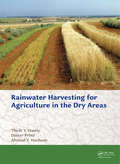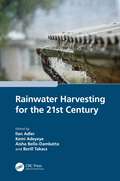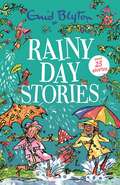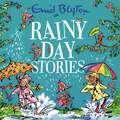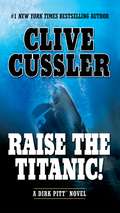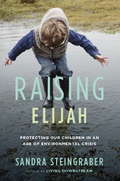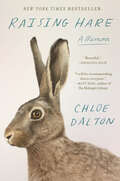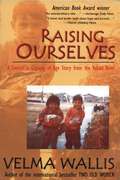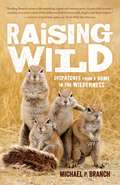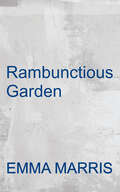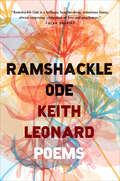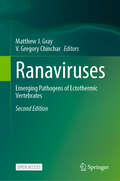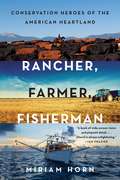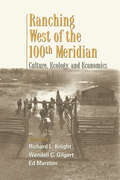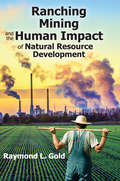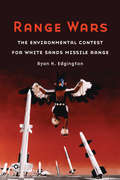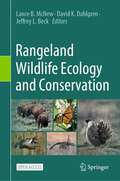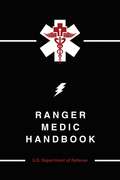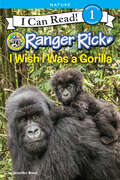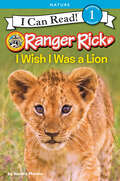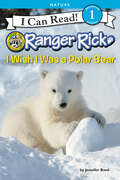- Table View
- List View
Rainwater Harvesting for Agriculture in the Dry Areas
by Theib Y. Oweis Dieter Prinz Ahmed Y. HachumDry areas suffer not only from limited rainfall but alsonatural leakage'-90% of rainwater is lost directly or indirectly, and is unavailable for agriculture or domestic use. Water harvesting is a low-cost, easy-to-use, environmentally-friendly way to recover a large part of this lost water. How does water harvesting work? Which sites or areas are
Rainwater Harvesting for the 21st Century
by Kemi Adeyeye Ilan Adler Aisha Bello-Dambatta Berill TakacsAccess to water in many parts of the world is increasingly challenging due to scarcity, quality issues and lack of access to adequate supply infrastructure. Currently, over 2 billion people around the world experience high water stress, and about 4 billion people experience severe water scarcity for at least one month on an annual basis. Rainwater harvesting (RWH) is increasingly seen as both an excellent alternative source of water and a valuable climate change adaptation measure. However, large-scale adoption remains challenging in many parts of the globe. This book, Rainwater Harvesting for the 21st Century, serves as a rigorous yet practical guide for a broad audience interested in the many opportunities that RWH systems can provide, including water and food security, flood management and climate change adaptation. It comprehensively covers the state of the art in RWH with practical examples of cutting-edge research and innovation in the design, operation and maintenance of RHW systems from both academics and practitioners. Highlights include: A comprehensive, transdisciplinary perspective of the latest advances in RWH techniques. Examples and case studies from around the world.
Rainy Day Stories (Bumper Short Story Collections #66)
by Enid BlytonPull on your welly boots for these short stories by the world's best-loved story teller. Ideal for children aged 5 and up!In this charming collection by Enid Blyton, children stumble upon secret rooms on rainy days and gnomes pretend they can forecast the weather. The rain may be pouring down in these stories, but there's plenty of mischief and adventure to be found. These classic tales are ideal for younger children being read to and for newly confident readers to read alone. Each story stands alone and is the perfect length for reading at bedtime or in the classroom. Enid Blyton remains one of Britain's favourite children's authors and her bumper short story collections are perfect for introducing her to the latest generation of readers. Read all of Enid Blyton's bumper short story collections. New in 2021: Rainy Day StoriesPet StoriesStories of Spells and EnchantmentsChristmas Tales *** Enid Blyton® and Enid Blyton's signature are registered trade marks of Hodder & Stoughton Limited. No trade mark or copyrighted material may be reproduced without the express written permission of the trade mark and copyright owner.
Rainy Day Stories (Bumper Short Story Collections #66)
by Enid BlytonPull on your welly boots for these short stories by the world's best-loved story teller. Ideal for children aged 5 and up!In this charming collection by Enid Blyton, children stumble upon secret rooms on rainy days and gnomes pretend they can forecast the weather. The rain may be pouring down in these stories, but there's plenty of mischief and adventure to be found. These classic tales are ideal for younger children being read to and for newly confident readers to read alone. Each story stands alone and is the perfect length for reading at bedtime or in the classroom. Enid Blyton remains one of Britain's favourite children's authors and her bumper short story collections are perfect for introducing her to the latest generation of readers. Read all of Enid Blyton's bumper short story collections. New in 2021: Rainy Day StoriesPet StoriesStories of Spells and EnchantmentsChristmas Tales *** Enid Blyton® and Enid Blyton's signature are registered trade marks of Hodder & Stoughton Limited. No trade mark or copyrighted material may be reproduced without the express written permission of the trade mark and copyright owner.(P)2021 Hodder & Stoughton Limited
Rainy Day Stories (Bumper Short Story Collections #66)
by Enid BlytonPull on your welly boots for these short stories by the world's best-loved story teller. Ideal for children aged 5 and up!In this charming collection by Enid Blyton, children stumble upon secret rooms on rainy days and gnomes pretend they can forecast the weather. The rain may be pouring down in these stories, but there's plenty of mischief and adventure to be found. These classic tales are ideal for younger children being read to and for newly confident readers to read alone. Each story stands alone and is the perfect length for reading at bedtime or in the classroom. Enid Blyton remains one of Britain's favourite children's authors and her bumper short story collections are perfect for introducing her to the latest generation of readers. Read all of Enid Blyton's bumper short story collections. New in 2021: Rainy Day StoriesPet StoriesStories of Spells and EnchantmentsChristmas Tales *** Enid Blyton® and Enid Blyton's signature are registered trade marks of Hodder & Stoughton Limited. No trade mark or copyrighted material may be reproduced without the express written permission of the trade mark and copyright owner.
Rainy, Sunny, Blowy, Snowy: What Are Seasons? (Into Reading, Big Book Module 7)
by Jane BrocketNIMAC-sourced textbook
Raise the Titanic! (Dirk Pitt Adventure #3)
by Clive CusslerOn orders from the Pentagon, marine explorer Dirk Pitt must salvage crucial material from the world's most infamous maritime disaster in this novel in the #1 New York Times-bestselling series.The President's secret task force has developed an unprecedented defensive weapon that relies on an extremely rare radioactive element—and Dirk Pitt has followed a twisted trail to a secret cache of the substance. Now, racing against brutal storms, Soviet spies, and a ticking clock, Pitt begins his most thrilling mission—to raise from its watery grave the shipwreck of the century...
Raising Elijah: Protecting Our Children In An Age Of Environmental Crisis (A\merloyd Lawrence Book Ser.)
by Sandra SteingraberNothing could be more important than the health of our children, and no one is better suited to examine the threats against it than Sandra Steingraber. Once called "a poet with a knife," she blends precise science with lyrical memoir. In Living Downstream she spoke as a biologist and cancer survivor; in Having Faith she spoke as an ecologist and expectant mother, viewing her own body as a habitat. Now she speaks as the scientist mother of two young children, enjoying and celebrating their lives while searching for ways to protect them--and all children--from the toxic, climate-threatened world they inhabit Each chapter of this engaging and unique book focuses on one inevitable ingredient of childhood--everything from pizza to laundry to homework to the "Big Talk"--and explores the underlying social, political, and ecological forces behind it. Through these everyday moments, Steingraber demonstrates how closely the private, intimate world of parenting connects to the public world of policy-making and how the ongoing environmental crisis is, fundamentally, a crisis of family life.
Raising Hare: A Memoir
by Chloe DaltonA moving and fascinating meditation on freedom, trust, loss, and our relationship with the natural world, explored through the story of one woman’s unlikely friendship with a wild hare. <p> Imagine you could hold a baby hare and bottle-feed it. Imagine that it lived under your roof and lolloped around your bedroom at night, drumming on the duvet cover when it wanted your attention. Imagine that, over two years later, it still ran in from the fields when you called it and slept in your house for hours on end and gave birth to leverets in your study. For political advisor and speechwriter Chloe Dalton, who spent lockdown deep in the English countryside, far away from her usual busy London life, this became her unexpected reality. <p> In February 2021, Dalton stumbles upon a newborn hare—a leveret—that had been chased by a dog. Fearing for its life, she brings it home, only to discover how impossible it is to rear a wild hare, most of whom perish in captivity from either shock or starvation. Through trial and error, she learns to feed and care for the leveret with every intention of returning it to the wilderness. Instead, it becomes her constant companion, wandering the fields and woods at night and returning to Dalton’s house by day. Though Dalton feared that the hare would be preyed upon by foxes, stoats, feral cats, raptors, and even people, she never tried to restrict it to the house. Each time the hare leaves, Chloe knows she may never see it again. Yet she also understands that to confine it would be its own kind of death. <p> Raising Hare chronicles their journey together, while also taking a deep dive into the lives and nature of hares, and the way they have been viewed historically in art, literature, and folklore. We witness first-hand the joy at this extraordinary relationship between human and animal, which serves as a reminder that the best things, and most beautiful experiences, arise when we least expect them. “A beautiful book that makes you think profoundly about how we so often tune out the natural world around us. Chloe Dalton is a tender, curious, wise, mind-expanding guide, connecting readers with the wild we humans once knew so well. I will be recommending this to everyone.”—Matt Haig, author of The Midnight Library. <b>New York Times Bestseller</b>
Raising Ourselves: A Gwich'in Coming Of Age Story From The Yukon River
by Velma WallisBorn in 1960, the sixth of thirteen children, Velma Wallis comes of age in a two-room log cabin in remote Fort Yukon, Alaska. Life is defined by the business of living off the land. Chopping wood. Hauling water from the river. Hunting moose. Catching salmon. Traping fur. Taking care of the dogs. For a thousand years, the Gwich'in clan had followed migratory animals across the north. But two generations before, the people had settled where the Porcupine River flows into the Yukon. Now, the Wallis family has a post office box and an account at the general store, and Velma listens to Wolf Man Jack on armed forces radio. The author discovers that her people have surrendered their language, traditional values, and religion to white teachers, traders, and missionaries. Flu epidemics have claimed many loved ones. Village elders seem like strangers from another land, and in a way they are. There is much drinking when the monthly government checks come, and that is when the pain comes out of hiding. RAISING OURSELVES is a gritty, sobering, yet irresistible story filled with laughter even as generations of Gwich'in grief seeps from past to present. But hope pushes back hopelessness, and a new strength and wisdom emerge.
Raising Oysters (Fountas & Pinnell LLI Purple #Level R)
by Sarah BrockettSome people think oysters are gross, slimy blobs. Others think these slippery shellfish taste wonderfully delicious. Some people value oysters for their possible secret treasure: a pearl growing inside.
Raising Wild
by Michael P. Branch"Combining natural history, humor, and personal narrative, Raising Wild is an intimate exploration of Nevada's Great Basin Desert, the wild and extreme land of high desert caliche and juniper, of pronghorn antelope and mountain lions, where wildfires and snowstorms threaten in equal measure. Within this remote, high desert landscape sits the home of Michael Branch, where he, his wife, and their two curious little girls brazenly live among the packrats and ground squirrels, rattlesnakes and scorpions. In Branch's hands, this exceedingly barren and stark landscape becomes a place teeming with energy, surprise, and an endless web of connections that ultimately includes his family and home. It is in this desert setting where, in building a ladder to the stars, one can find a connection to the past and to the heavens; where his children's first garden becomes not the quaint blossoming of seed to flower and fruit but a smoke bomb-drenched exhibit of futility in the face of the inhospitable desert environment; where the surprise of fire acts as a reminder all too real of the unknowable that awaits us and for which we can never fully prepare. In this exhilarating, lyrical, and humorous exploration of natural history, Branch reveals a desert wilderness in which our ideas about nature and ourselves are challenged and transformed. "
Rambunctious Garden: Saving Nature in a Post-Wild World
by Emma MarrisA paradigm shift is roiling the environmental world. For decades people have unquestioningly accepted the idea that our goal is to preserve nature in its pristine, pre-human state. But many scientists have come to see this as an outdated dream that thwarts bold new plans to save the environment and prevents us from having a fuller relationship with nature. Humans have changed the landscapes they inhabit since prehistory, and climate change means even the remotest places now bear the fingerprints of humanity. Emma Marris argues convincingly that it is time to look forward and create the "rambunctious garden," a hybrid of wild nature and human management.
Ramshackle Ode: Poems
by Keith LeonardA sparkling debut collection from a Pushcart Prize-nominated poet that makes an ecstatic argument for living Containing joy and suffering side by side, Ramshackle Ode offers elegies and odes as necessary partners to bring out the greatest power in each. By turns celebratory, meditative, tender, and rebellious, these poems reimagine the divisions and intersections of life and death, the human and the natural world, the brutal and the beautiful. Time and again, they choose hope.From an award-winning young poet in the tradition of Marie Howe, Walt Whitman, Gerald Stern, and contemporary American bard Maurice Manning, Ramshackle Ode presents a new voice singing toward transcendence, offering the sense that, though this world is fragile, human existence is a wonderfully stubborn miracle of chance.
Ranaviruses: Emerging Pathogens of Ectothermic Vertebrates
by Matthew J. Gray V. Gregory ChincharThis is a open access book. Ranaviruses, double-stranded DNA viruses (family Iridoviridae) that cause systemic, life-threatening disease in a variety of amphibians, reptiles and fish, have contributed to mass die-offs of both wild and captive populations around the globe. These viruses are emerging and increasingly responsible for population declines of ectothermic vertebrates. Because amphibians, reptiles, and freshwater turtles are suitable hosts and among the most imperiled vertebrate taxa in the world, ranaviruses can have significant impacts on biodiversity and ecosystem function. Additionally, many fish that are raised in aquaculture facilities and traded internationally are suitable hosts; thus, the potential economic impact of ranaviruses is significant. Ranaviruses also serve as a model for understanding viral replication and gene function among large double-stranded DNA viruses, e.g., poxviruses, asfarvirus, and ascoviruses. Lastly, study of the host immune response to ranaviral disease and the identification of viral immune evasion genes that negatively regulate host immune functions provide insight into which specific immune elements are most important in protecting host species against severe disease. The effort to produce a 2nd edition of our earlier work grew out of a recent meeting (1st Global Amphibian and Reptile Disease Conference) held in August 2022. Given the continued research in ranaviruses and ranaviral disease since the first edition, this new book updates the latest information on ranaviruses and provides guidance on how to monitor and manage ranaviruses in cold-blooded vertebrate populations.
Rancher, Farmer, Fisherman: Conservation Heroes of the American Heartland
by Miriam HornThe story of a huge, largely hidden, and entirely unexpected conservation movement in America. Many of the men and women doing today's most consequential environmental work--restoring America's grasslands, wildlife, soil, rivers, wetlands, and oceans--would not call themselves environmentalists; they would be too uneasy with the connotations of that word. What drives them is their deep love of the land: the iconic terrain where explorers and cowboys, pioneers and riverboat captains forged the American identity. They feel a moral responsibility to preserve this heritage and natural wealth, to ensure that their families and communities will continue to thrive. Unfolding as a journey down the Mississippi River, Rancher, Farmer, Fisherman tells the stories of five representatives of this stewardship movement: a Montana rancher, a Kansas farmer, a Mississippi riverman, a Louisiana shrimper, and a Gulf fisherman. In exploring their work and family histories and the essential geographies they protect, Rancher, Farmer, Fisherman challenges pervasive and powerful myths about American and environmental values.
Ranching West of the 100th Meridian: Culture, Ecology, and Economics
by Richard L. Knight Ed Marston Wendell GilgertRecommended by The Nature Conservancy magazine.Ranching West of the 100th Meridian offers a literary and thought-provoking look at ranching and its role in the changing West. The book's lyrical and deeply felt narratives, combined with fresh information and analysis, offer a poignant and enlightening consideration of ranchers' ecological commitments to the land, their cultural commitments to American society, and the economic role ranching plays in sustainable food production and the protection of biodiversity.The book begins with writings that bring to life the culture of ranching, including the fading reality of families living and working together on their land generation after generation. The middle section offers an understanding of the ecology of ranching, from issues of overgrazing and watershed damage to the concept that grazing animals can actually help restore degraded land. The final section addresses the economics of ranching in the face of declining commodity prices and rising land values brought by the increasing suburbanization of the West. Among the contributors are Paul Starrs, Linda Hasselstrom, Bob Budd, Drummond Hadley, Mark Brunson, Wayne Elmore, Allan Savory, Luther Propst, and Bill Weeks.Livestock ranching in the West has been attacked from all sides -- by environmentalists who see cattle as a scourge upon the land, by fiscal conservatives who consider the leasing of grazing rights to be a massive federal handout program, and by developers who covet intact ranches for subdivisions and shopping centers. The authors acknowledge that, if done wrong, ranching clearly has the capacity to hurt the land. But if done right, it has the power to restore ecological integrity to Western lands that have been too-long neglected. Ranching West of the 100th Meridian makes a unique and impassioned contribution to the ongoing debate on the future of the New West.
Ranching, Mining, and the Human Impact of Natural Resource Development
by Raymond L. GoldIn Ranching, Mining, and the Human Impact of Natural Resource Development, Raymond L. Gold observes and reports on people whose lives have been significantly affected by the industrialization of rural communities in the American West. Such community change research is rarely done, so this classic study is invaluable for its real world groundings applicable to a variety of social science theories. The study evolved out of ethnographic research on Western communities done over a full decade.This was the first work of its kind to examine and account for the rise of local citizens' groups on the sense of being a community. Its account of this process covers both ordinarily slow and extraordinarily rapid areas of change in the American West. In this regard it is a contribution to basic social theory, showing clearly the interrelation between small-community and large-society elements of the structure and functioning of community life. No other book brings together the story of social effects of natural resource development projects in the American West.This book shows how to implement a social policy concerning resource development and public agencies. It is intended for people interested in the environment, American society, rural and urban affairs, social impact assessment, and urban structures generally. It is also aimed at industrial and community planners and natural resource development firms.
Range Wars: The Environmental Contest for White Sands Missile Range
by Ryan H. EdgingtonEstablished in south-central New Mexico at the end of World War II, White Sands Missile Range is the largest overland military reserve in the western hemisphere. It was the site of the first nuclear explosion, the birthplace of the American space program, and the primary site for testing U.S. missile capabilities.In this environmental history of White Sands Missile Range, Ryan H. Edgington traces the uneasy relationships between the military, the federal government, local ranchers, environmentalists, state game and fish personnel, biologists and ecologists, state and federal political figures, hunters, and tourists after World War II—as they all struggled to define and productively use the militarized western landscape. Environmentalists, ranchers, tourists, and other groups joined together to transform the meaning and uses of this region, challenging the authority of the national security state to dictate the environmental and cultural value of a rural American landscape. As a result, White Sands became a locus of competing geographies informed not only by the far-reaching intellectual, economic, and environmental changes wrought by the cold war but also by regional history, culture, and traditions.
Rangeland Wildlife Ecology and Conservation
by Lance B. McNew David K. Dahlgren Jeffrey L. BeckThis open access book reviews the importance of ecological functioning within rangelands considering the complex inter-relationships of production agriculture, ecosystem services, biodiversity, and wildlife habitat. More than half of all lands worldwide, and up to 70% of the western USA, are classified as rangelands—uncultivated lands that often support grazing by domestic livestock. The rangelands of North America provide a vast array of goods and services, including significant economic benefit to local communities, while providing critical habitat for hundreds of species of fish and wildlife. This book provides compendium of recent data and synthesis from more than 100 experts in wildlife and rangeland ecology in Western North America. It provides a current and in-depth synthesis of knowledge related to wildlife ecology in rangeland ecosystems, and the tools used to manage them, to serve current and future wildlife biologists and rangeland managers in the working landscapes of the West. The book also identifies information gaps and serves as a jumping-off point for future research of wildlife in rangeland ecosystems. While the content focuses on wildlife ecology and management in rangelands of Western North America, the material has important implications for rangeland ecosystems worldwide.
Ranger Medic Handbook
by U.S. Department of DefenseHistorically in warfare, the majority of all combat deaths have occurred prior to a casualty ever receiving advanced trauma management. The execution of the Ranger mission profile in the Global War on Terrorism and our legacy tasks undoubtedly will increase the number of lethal wounds. Ranger leaders can significantly reduce the number of Rangers who die of wounds sustained in combat by simply targeting optimal medical capability in close proximity to the point of wounding. Directing casualty response management and evacuation is a Ranger leader task; ensuring technical medical competence is a Ranger Medic task. A solid foundation has been built for Ranger leaders and medics to be successful in managing casualties in a combat environment. The true success of the Ranger Medical Team will be defined by its ability to complete the mission and greatly reduce preventable combat death. Rangers value honor and reputation more than their lives, and as such will attempt to lay down their own lives in defense of their comrades. The Ranger Medic will do no less.
Ranger Rick: I Wish I Was a Gorilla (I Can Read Level 1)
by Jennifer BovéExplore the lives of gorillas with Ranger Rick in this beginning reader with full-color photos of gorillas in the wild! What if you wished you were a gorilla and then you became one? Could you eat like a gorilla? Sleep like a gorilla? Live in a gorilla family? And would you want to? Find out!Ranger Rick explorers can learn all about gorillas in this reader full of fascinating facts, vivid wildlife photographs, a Wild Words glossary, and a hands-on activity about how to make a snack like a gorilla! Ranger Rick: I Wish I Was a Gorilla is a Level One I Can Read, which means it’s perfect for children learning to sound out words and sentences. Whether shared at home or in a classroom, the short sentences, familiar words, and simple concepts of Level One books support success for children eager to start reading on their own.
Ranger Rick: I Wish I Was a Lion (I Can Read Level 1)
by Sandra MarkleDig into the lives of lions with Ranger Rick in this beginning reader with full-color photos of lions in the wild! What if you wished you were a lion? And then you became one? Could you eat like a lion? Sleep like a lion? Live in a lion family? And would you want to? Find out! Ranger Rick explorers can learn all about lions in this reader full of fascinating facts, vivid wildlife photographs, a Wild Words glossary, and a hands-on activity about practicing your lion-quick reflexes!Ranger Rick: I Wish I Was a Lion is a Level One I Can Read, which means it’s perfect for children learning to sound out words and sentences. Whether shared at home or in a classroom, the short sentences, familiar words, and simple concepts of Level One books support success for children eager to start reading on their own.
Ranger Rick: I Wish I Was a Polar Bear (I Can Read Level 1)
by Jennifer BovéExplore the lives of polar bears with Ranger Rick in this beginning reader with full-color photos of polar bears in the wild! What if you wished you were a polar bear and then you became one? Could you eat like a polar bear? Talk like a polar bear? Live in the cold Arctic tundra? And would you want to? Find out!Ranger Rick explorers can learn all about polar bears in this reader full of fascinating facts, vivid wildlife photographs, a Wild Words glossary, and a paws-on activity that shows readers how blubber works using ice water and vegetable shortening! Ranger Rick, the iconic raccoon ambassador from Ranger Rick magazine, asks questions like: Would you want to nap on the snow? Brrr!Ranger Rick: I Wish I Was a Polar Bear is a Level One I Can Read book, which means it’s perfect for children learning to sound out words and sentences. Whether shared at home or in a classroom, the short sentences, familiar words, and simple concepts of Level One books support success for children eager to start reading on their own.
